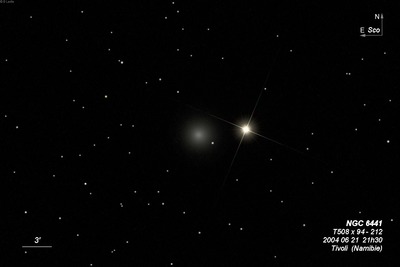
80mm finder (7/14/99): the globular was easily visible at 21x in the finder.
James Dunlop discovered NGC 6441 = D 557 = h3705 on 13 May 1826 with his 9-inch f/12 reflector at Paramatta. He described "a small well-defined rather bright nebula, about 20 arcseconds diameter, a very small star precedes it, but it is not involved; following gamma Telescopii." He observed this globular on 5 nights and his position is just 2' south of center (unusually accurate for him).
John Herschel first recorded on 28 Jun 1834, "globular cluster, B, R, 90", vgbM, resolvable (barely so), a very regularly graduating neb or cluster; in field with gamma Telescopii." The next night he logged "globular, B, R, vgbM, up to a blaze. In field with Gamma Telescopii, and nearly on the same parallel; with left eye I barely see it resolved into stars 18 or 20m. The whole ground of the heavens, for an immense extent, is thickly sown with such stars. A beautiful object." Christian Peters claimed he discovered it around 1850, while at the Capodimonte Observatory in Naples (AJ 2, 1856).
200/250mm - 8" (5/21/82): bright, intense core.
300/350mm - 13" (6/18/85): very bright core, mottled halo but no certain resolution. Located just 4.5' E of G Scorpii (V = 3.2), which hampers viewing.
400/500mm - 17.5" (7/14/99): NGC 6441 is situated just 4.5' following mag 3.2 G Scorpii! At 220x it appeared moderately bright, round, ~2.7' diameter, fairly sharp concentration with a prominent 1' core. A mag 11 field star is at the southwest edge of the halo (1.3' SW of center), a mag 13.5 star is just inside the west edge of the halo (1.2' from center), and a mag 12.5-13 star is just off the northwest side. There was no definite resolution into cleanly visible stars, although the globular had a granular appearance. H 1-36, a symbiotic star (mimics a stellar planetary), is located just 1.3' NW of the mag 3.2 star!
Notes by Steve Gottlieb